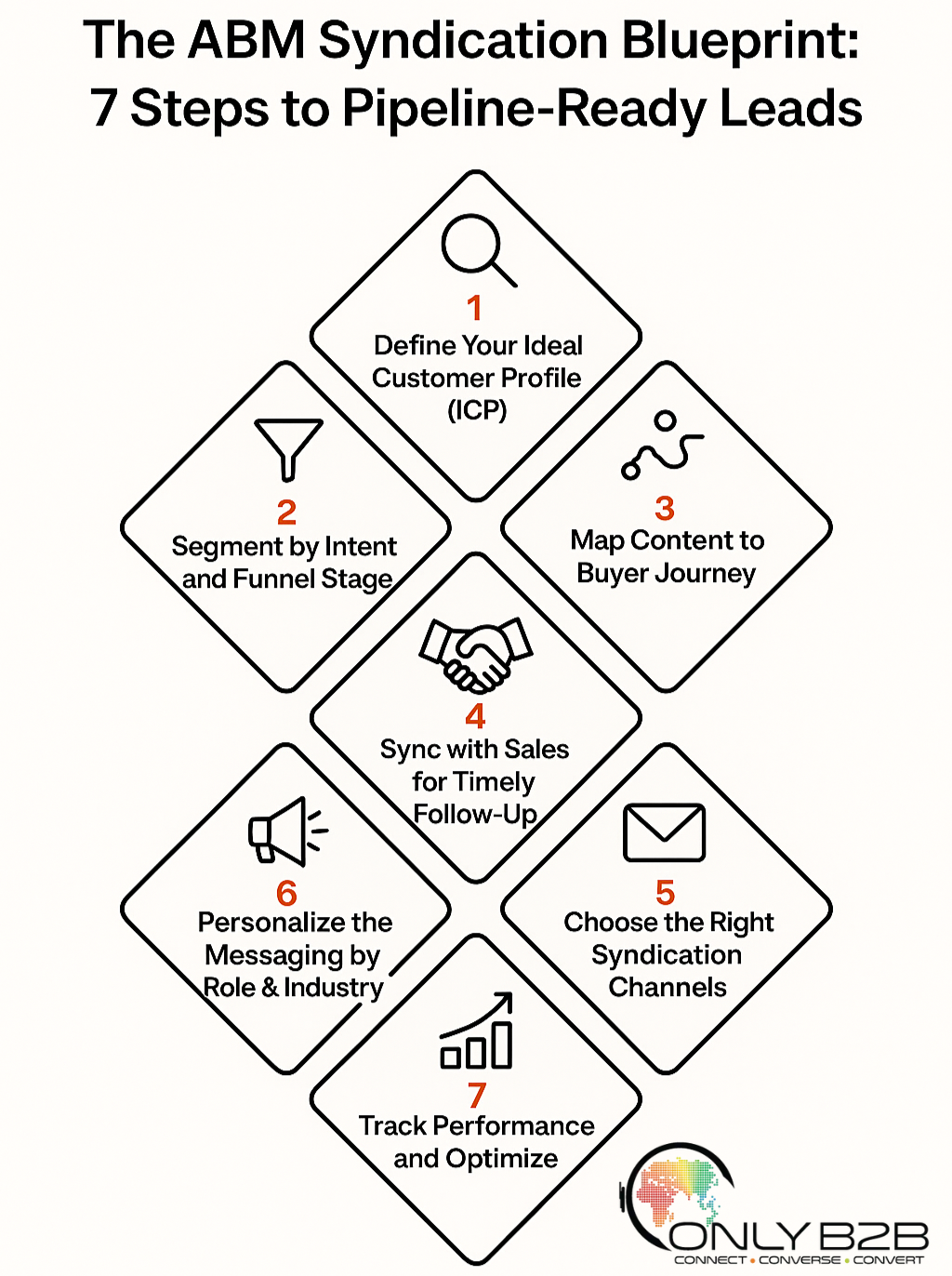Are you exploring cost-effective ways to generate high-quality B2B leads? If so, you’ve likely built a solid content marketing foundation — complete with eBooks, whitepapers, webinars, and blogs designed to nurture prospects throughout the buyer’s journey.
But capturing attention in today’s crowded digital landscape takes more than just publishing good content. To reach specific high-value accounts actively seeking your solutions, you need precision targeting and timely delivery — and that’s where account-based marketing (ABM) combined with content syndication becomes a game-changer.
While ABM provides a strategic framework for engaging key accounts, content syndication helps you scale that engagement by distributing your message across trusted platforms and channels. When executed well, this pairing not only drives brand visibility and thought leadership but also delivers leads from accounts already showing buying intent.
This is what makes ABM-powered content syndication such a powerful revenue engine. By aligning your top-performing content with the right audience at the right time, you move beyond lead capture — and into pipeline acceleration.
If you’re new to this approach, you might be wondering whether it’s worth the effort or where to begin. Don’t worry — in this guide, we’ll walk you through the fundamentals, benefits, and strategic steps to leverage ABM content syndication effectively for your lead generation goals.
Why ABM + Content Syndication is a Winning Combination
Table of Contents
- 1 Why ABM + Content Syndication is a Winning Combination
- 2 The ABM Syndication Blueprint: 7 Steps to Pipeline-Ready Leads
- 3 How ABM Content Syndication Converts Strategy Into Real Growth
- 4 FAQs on ABM Content Syndication
- 5 Final Thought:
When executed in isolation, content syndication offers marketers the benefit of extended reach, long-term visibility, and valuable backlinks. But when you combine content syndication with an Account-Based Marketing (ABM) strategy, it becomes a precision tool for pipeline acceleration.
Instead of publishing content for the masses, ABM-powered syndication enables you to republish your best assets on trusted third-party platforms — but only for the accounts that matter most. This isn’t just about brand awareness; it’s about delivering content to high-intent decision-makers across your exact ICP.
Here’s why this combination works so well:
Targeted Distribution at Scale
Syndication lets you get your content in front of hundreds (or thousands) of potential leads — but ABM ensures that those leads are from the right companies, roles, and industries.
Reach Accounts Deeper in the Funnel
By using intent signals and behavioral data, you can tailor syndication efforts to accounts that are already exploring solutions like yours.
Shorten Sales Cycles
When buyers engage with tailored, relevant content early on, your sales team spends less time educating and more time closing.
Strategic Brand Authority
When your content is published on respected platforms and targeted with precision, it not only boosts your visibility — it increases perceived expertise.
Full-Funnel Lead Creation
This strategy doesn’t just generate leads at the top. With the right content mapped to funnel stages, you’ll get conversions at every level of the buyer’s journey.
Content syndication for lead generation plays a key role in amplifying this impact by distributing that content to a wider, targeted audience.
Better Alignment Between Marketing and Sales
ABM content syndication delivers qualified, research-ready leads, enabling SDRs and AEs to follow up with insight and context — not cold outreach.
In short, ABM content syndication isn’t just about increasing traffic — it’s about driving the right traffic from the right accounts and converting that attention into qualified pipeline.
The ABM Syndication Blueprint: 7 Steps to Pipeline-Ready Leads
You must be excited to include content syndication into your ABM strategy now that you’ve learned everything about its advantages.
If you’re exploring effective account based marketing tactics, content syndication is one of the most impactful approaches. The good news is that we’ve already put out a guide to assist you with ABM content syndication.
The stages to creating an ABM content syndication plan for lead generation is as follows:

1. Define Your Ideal Customer Profile (ICP)
The foundation of any ABM strategy is knowing exactly who you’re targeting — and that means building a crystal-clear Ideal Customer Profile (ICP). Your ICP isn’t just a target market; it’s a precise representation of the companies most likely to convert, retain, and expand with your solution.
How to Build It:
- Firmographics: Company size, industry, location, annual revenue
- Technographics: Tools and platforms they already use (e.g., Salesforce, HubSpot, AWS)
- Buying committee structure: Who’s involved in decisions — IT, Marketing, Procurement, etc.
- Pain points and goals: What they’re trying to solve and achieve
Real Use Case:
A cybersecurity SaaS firm identified their best-fit clients as mid-sized financial institutions with legacy infrastructure and recent data breach incidents. This narrowed their syndication efforts to ~1,500 accounts instead of wasting impressions on 15,000.
Tool Tips:
Use ABM platforms like ZoomInfo, Clearbit, and Lusha to enrich firmographic and technographic data. Use Bombora to add intent layers (we’ll expand on this below).
2. Segment by Intent and Funnel Stage
ABM is all about relevance and timing. Even if a company fits your ICP, if they’re not currently researching a solution like yours, your content won’t land.
That’s why layering intent data is crucial. Intent data tools like Bombora, G2, and 6sense can tell you which accounts are actively researching keywords or competitors in your category.
How to Segment:
- TOFU (Top of Funnel): Accounts showing passive interest or industry curiosity
- MOFU (Middle of Funnel): Accounts engaging with solution-focused content (e.g., “best ABM tools”)
- BOFU (Bottom of Funnel): Accounts reading reviews, comparing vendors, or downloading pricing guides
Intent Triggers to Watch:
- Spikes in traffic to ABM-related topics
- Increased engagement with competitor content
- Surge in job postings related to buying your product (e.g., hiring a Demand Gen Manager)
Pro Tip:
Build dynamic audience segments in your CRM/MAP (e.g., HubSpot, Marketo) to route accounts into syndication workflows based on intent scoring.
3. Map Content to Buyer Journey
Once you know who you’re targeting and where they are in the journey, the next step is to match your content to their mindset. This ensures relevance, improves engagement, and increases the chance of conversion.
| Funnel Stage | Goal | Best Content Types |
|---|---|---|
| TOFU | Create awareness | eBooks, industry reports, blogs, infographics |
| MOFU | Build trust and educate | Webinars, comparison guides, use cases |
| BOFU | Nurture urgency and conversion | ROI calculators, case studies, demo videos |
Example:
Instead of syndicating a “Why ABM Matters” whitepaper to CFOs already comparing tools, send them a “ROI Benchmark Report: What to Expect from ABM” asset with a strong CTA for a consultation.
4. Sync with Sales for Timely Follow-Up
ABM content syndication is only powerful when marketing and sales are fully aligned. Without smart follow-up, even the best campaigns fail to move leads through the pipeline.
This alignment ensures that prospects are nurtured effectively across the B2B sales cycle stages, turning interest into real opportunities.
Why Follow-Up Matters:
- According to InsideSales, 35-50% of deals go to the vendor who responds first
- Syndicated leads often go cold without personalized engagement within 24–48 hours
What to Do:
- Route engaged leads to SDRs in real-time using integrations (Zapier, Tray.io)
- Arm sales with content-specific insights (e.g., “Jane from Company X downloaded the ABM calculator — follow up with a case study or personalized pitch”)
- Use intent + content journey to personalize outreach — “Since you explored our ABM ROI guide…”
Pro Tip:
Integrate syndication platforms directly with your CRM to tag and score leads for automated workflows.
5. Choose the Right Syndication Channels
One of the biggest mistakes in content syndication is over-relying on email. While email is still a core driver, modern syndication must be multichannel.
Effective ABM Syndication Channels:
- Email Syndication: Still valuable for TOFU but needs personalization
- LinkedIn InMail & Sponsored Posts: Great for MOFU and role-based targeting
- Content Platforms (Only B2B, NetLine, Madison Logic): Scale reach with intent layering
- Quora Ads, Reddit, Programmatic: For broader reach and niche segment engagement
Selection Tip:
Match channels to audience behavior. If you’re targeting CMOs, LinkedIn > Email. If targeting developers, Reddit > LinkedIn.
6. Personalize the Messaging by Role & Industry
No matter how good your content is, if your messaging sounds generic, it gets ignored. This is where micro-personalization gives you a big advantage.
Where to Personalize:
- Subject lines and preheaders
- Content intros or previews
- Landing pages or CTA blocks
Example Personalizations:
- “How ABM is Reshaping Marketing Strategy in Fintech” → for Fintech CMOs
- “The ABM Tech Stack Your IT Director Actually Needs” → for CIOs
Tools to Help:
Use UTM parameters and smart fields in platforms like Instapage, Unbounce, or Marketo to dynamically adapt your landing experience.
7. Track Performance and Optimize
Your ABM syndication campaign is a living strategy — and your KPIs should reflect business impact, not just vanity metrics.
Track These Metrics:
- Lead engagement rate (opens, clicks, time on content)
- Lead-to-opportunity conversion rate
- Average deal velocity for syndicated vs. non-syndicated leads
- Pipeline influence and revenue attribution
Optimization Levers:
- Drop underperforming assets or channels
- Repackage top content (e.g., webinar → eBook → carousel)
- Shift budget toward high-intent segments or faster-moving accounts
Reporting Tip:
Use multi-touch attribution models in your CRM to understand which content + channel + message combinations are creating the most revenue.
How ABM Content Syndication Converts Strategy Into Real Growth
If you’ve made it this far, you’ve seen how much more powerful ABM content syndication is than simply pushing content out and hoping it lands somewhere useful.
This strategy lets you reach the exact people who matter — those already exploring solutions like yours — and deliver helpful, timely information that builds trust and starts real conversations.
When your content reaches decision-makers in the right accounts, you’re no longer chasing leads. You’re guiding them.
The real advantage of content syndication under an ABM lens isn’t just reach — it’s relevance. You’re not talking to everyone. You’re talking to people:
- Who fit your ideal customer profile
- Who’ve shown signs of active interest
- And who are more likely to convert when your message aligns with their current needs
This creates shorter sales cycles, better-fit leads, and stronger conversion rates.
A Few Things to Keep in Mind:
Not all content is equal.
Map what you syndicate to where the buyer is in their journey. Intro blog posts won’t convert bottom-funnel buyers. And detailed ROI calculators won’t make sense to someone who’s just starting to explore their challenges.
Ask them if they offer role-specific, industry-specific, and intent-filtered targeting. If they can’t, they may just be running email blasts to random databases.
Don’t syndicate and forget.
Follow up with context. If a prospect downloaded your mid-funnel checklist, that’s not just a lead — it’s a signal. Make sure sales sees that and knows what to do with it.
Real Impact Looks Like This:
When content syndication works in sync with your ABM playbook:
- SDRs spend less time qualifying and more time closing
- Your team stops guessing what accounts want — because you’ve already given it to them
- And your content stops being just “marketing material” and starts being part of your sales engine
This isn’t theory. It’s a system you can set up, test, and optimize — and once you do, you’ll never go back to a spray-and-pray approach again.
Want a quick reference version of this guide?
We’ve put together a clean, 1-page ABM Content Syndication PDF that summarizes the 7-step ABM content syndication strategy, perfect for:
- Sharing with your sales or demand gen team
- Adding to your QBR, training, or strategy decks
- Printing out for internal campaign planning
- Reviewing a real ABM content syndication example in action
📘 The Ultimate 2025 Playbook for B2B Content Syndication
If you’re serious about generating qualified B2B leads in 2025, this is the strategy guide your team needs. We’ve distilled the most effective content syndication techniques into a crisp, action-ready 1-pager that’s been crafted for marketing and demand gen pros ready to scale.
- 📍 Proven channel frameworks for high-intent reach
- 📊 Funnel-stage alignment strategies for every asset
- 🎯 Optimization tactics for faster pipeline movement
This isn’t just another checklist. It’s your blueprint to smarter syndication that actually drives revenue.
📩 Download the Free Strategy GuideFAQs on ABM Content Syndication
ABM content syndication is the process of distributing high-value content (like whitepapers, case studies, or guides) to a carefully selected list of target accounts based on your ABM strategy. It focuses on relevance, not reach.
Traditional content syndication casts a wide net, while ABM syndication uses data like firmographics and intent signals to deliver content specifically to high-value, sales-ready accounts.
Effective content includes mid-to-bottom-of-funnel assets like ROI calculators, executive guides, demo videos, and industry-specific case studies. The key is matching content to funnel stage and role.
Look for platforms that support role-based, intent-driven targeting, such as Only B2B, NetLine, or Madison Logic. These platforms allow you to distribute content to the right ICP segments.
Yes. Because you’re reaching decision-makers who are already researching your solution, ABM content syndication helps reduce time spent on education and accelerates deal velocity.
Still have questions? Contact our experts or book a free strategy call to explore how this fits into your ABM playbook.
Final Thought:
Have you tried using ABM content syndication to support your sales pipeline?
What worked? What didn’t? Share your experience in the comments, we’re all learning, and your story might help someone else sharpen their strategy.

Vikas Bhatt is the Co-Founder of ONLY B2B, a premium B2B lead generation company that specializes in helping businesses achieve their growth objectives through targeted marketing & sales campaigns. With 10+ years of experience in the industry, Vikas has a deep understanding of the challenges faced by businesses today and has developed a unique approach to lead generation that has helped clients across a range of industries around the globe. As a thought leader in the B2B marketing community, ONLY B2B specializes in demand generation, content syndication, database services and more.





